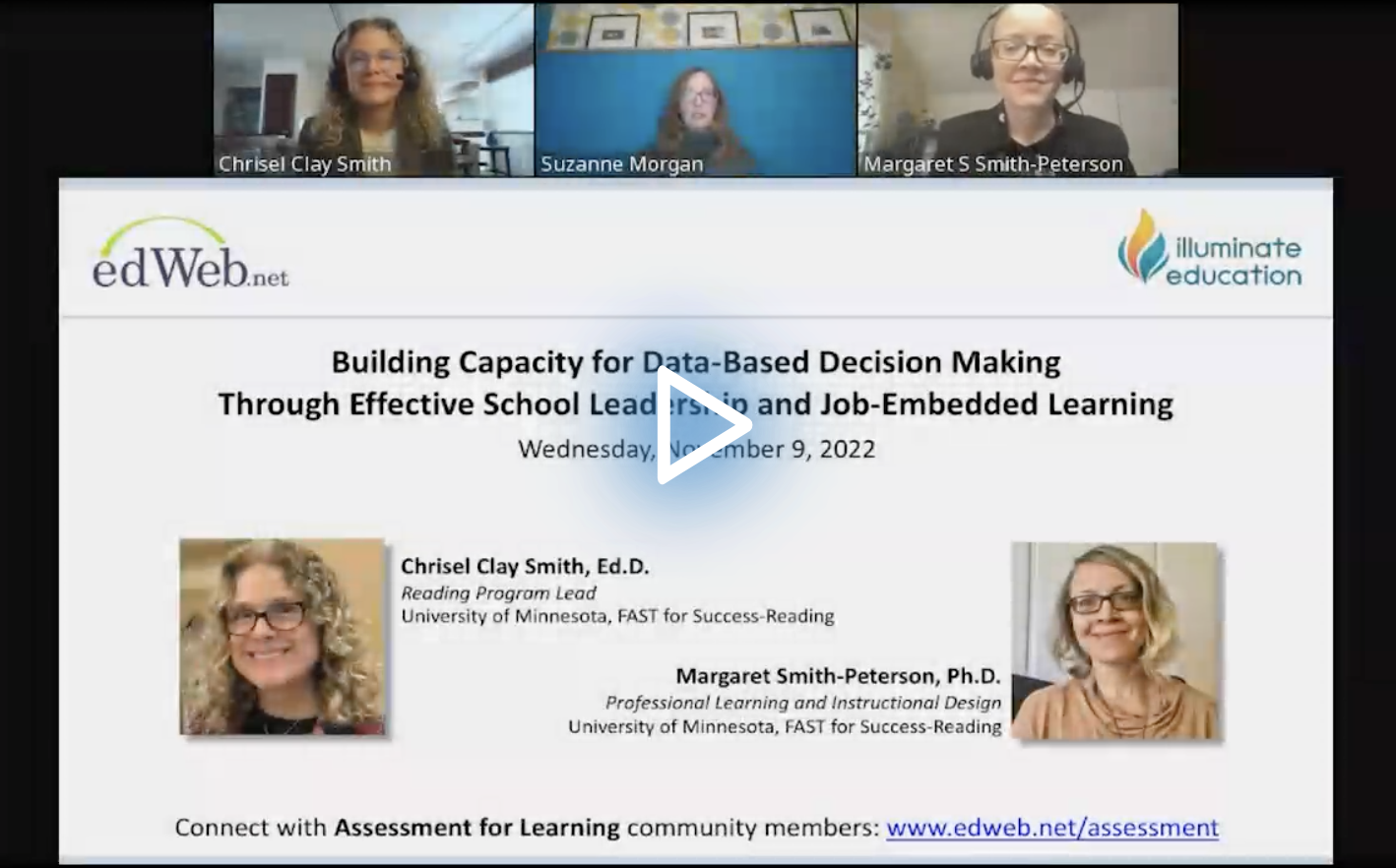Data-Based Decision Making Improves Instruction and Builds Capacity
Watch the Recording Listen to the Podcast
Using student data to guide instruction is not only an effective way to increase student achievement, but it can also help educators grow professionally as they continue to analyze new data, discuss its implications, and explore solutions.
Ways to use data to improve student outcomes and maximize educators’ learning process were the focus of the edLeader Panel, “Building Capacity for Data-Based Decision Making Through Effective School Leadership and Job-Embedded Learning,” featuring Chrisel Clay Smith, Ed.D., the Reading Program Lead for FAST for Success-Reading and a researcher at the University of Minnesota, and Margaret Smith-Peterson, Ph.D., Professional Development Lead and Instructional Designer for FAST for Success-Reading and also a researcher at the University of Minnesota.
The panelists noted the importance of bridging the gap between the craft of teaching and a scientific approach to working with data, which can be accomplished through effective data meetings and other forms of collaboration that also serve as job-embedded professional learning.
Improving Instruction
Dr. Smith-Peterson emphasized the importance of helping teachers develop the skills and background knowledge needed to interpret and use data effectively, in order to determine which professional practices are working well and then increase the use of those practices, while also continuing to improve them.
She recommended viewing data-based decision making as a systematic and cyclical process of collecting data, analyzing it and developing related hypotheses, and then using the data to develop and implement instructional plans that test the hypotheses. As part of this process, consideration also has to be to the quality of data and how useful it is in determining causation and potential improvements.
Regularly occurring data meetings are a key part of this process and should include consistent review of screening and progress monitoring data. Facilitators can be helpful in guiding the discussions and keeping them focused on classroom practices that will improve student learning. Providing opportunities for educators to learn from others’ successes, such as observing teachers in classrooms where growth is strong, can also contribute to the process.
Through a gradual release of responsibility, this approach can lead to educators becoming active learners, who engage in both learning by doing and socialized learning through a collaborative process. To support ongoing collaboration, the presenters recommended developing explicit and sequential collaboration protocols, so there is clear guidance about how the educators should work together.
Increasing Capacity
The active learning that occurs through ongoing data-based decision making can be a dynamic contributor to increased capacity within a school or district, especially when aligned with what Dr. Smith-Peterson called the “six dimensions of effective professional development.” These include targeted feedback and coaching, modeling and demonstrations with gradual release, and opportunities for professional collaboration, all of which should be sustained over time.
Another crucial aspect of capacity building is what Dr. Smith called “leadership for change,” citing Michael Fullan. This type of leadership includes the school principal or district administrator being an “agent of change” who moves processes forward, as well as a “system player” who makes sure the educational systems are increasing student achievement. A third key role is leading the learning of the staff through an ongoing process that builds shared mindsets.
With educator input and buy-in, a school or district can establish an effective process for change and growth that includes school improvement plans, buildingwide goals, and a Multi-Tiered System of Support for students, as well as a professional learning plan for the staff.
One result of combining all these processes and plans can be the development of “collective efficacy”—the belief a team can accomplish its goals. As educators see their instruction become more effective and students’ outcomes improve, the educators develop more confidence and more positive attitudes about their professional practices, and can apply what they have learned to other aspects of the education system in which they work.
That system includes not just the policies and procedures, curricula, instructional practices, and school schedules, but also the dynamic social systems and other hidden complexities that may be impacting the educators’ work and students’ outcomes. Professional learning about both the visible and hidden aspects of the education system can be combined with data-based decision making to generate further improvements in classroom instruction and student achievement.
Learn more about this edWeb broadcast, “Building Capacity for Data-Based Decision Making Through Effective School Leadership and Job-Embedded Learning,” sponsored by Illuminate Education.
Watch the Recording Listen to the Podcast
Join the Community
Assessment for Learning is a free professional learning community where educators can learn from top experts about effective assessment practices.
Illuminate Education equips educators to take a data-driven approach to serving the whole child. Our solution combines comprehensive assessment, MTSS collaboration and management, and real-time dashboard tools, and puts them in the hands of educators. As a result, educators can monitor learning and growth, identify academic and SEB needs, and align targeted supports in order to accelerate learning for each student.
Blog post by Robert Low, based on this edLeader Panel





Comments are closed.